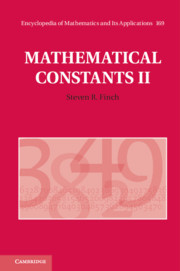Description
Mathematical Constants II
Encyclopedia of Mathematics and its Applications Series
Author: Finch Steven R.
The continuation of an outstanding scholarly attempt to bring together all significant mathematical constants in one place.
Language: English
Subject for Mathematical Constants II:
Approximative price 175.79 €
In Print (Delivery period: 14 days).
Add to cart
Publication date: 12-2018
782 p. · 16x24.1 cm · Hardback
782 p. · 16x24.1 cm · Hardback
Description
/li>Contents
/li>Biography
/li>
Famous mathematical constants include the ratio of circular circumference to diameter, ? = 3.14 ?, and the natural logarithm base, e = 2.718 ?. Students and professionals can often name a few others, but there are many more buried in the literature and awaiting discovery. How do such constants arise, and why are they important? Here the author renews the search he began in his book Mathematical Constants, adding another 133 essays that broaden the landscape. Topics include the minimality of soap film surfaces, prime numbers, elliptic curves and modular forms, Poisson?Voronoi tessellations, random triangles, Brownian motion, uncertainty inequalities, Prandtl?Blasius flow (from fluid dynamics), Lyapunov exponents, knots and tangles, continued fractions, Galton?Watson trees, electrical capacitance (from potential theory), Zermelo's navigation problem, and the optimal control of a pendulum. Unsolved problems appear virtually everywhere as well. This volume continues an outstanding scholarly attempt to bring together all significant mathematical constants in one place.
1. Number theory and combinatorics; 2. Inequalities and approximation; 3. Real and complex analysis; 4. Probability and stochastic processes; 5. Geometry and topology; Index.
Steven R. Finch is Research Computing Specialist at the Massachusetts Institute of Technology, Sloan School of Management. He is honoured to have received a Book Fellowship from the Clay Mathematics Institute and a Ford award for expository excellence. After the publication of the first volume of Mathematical Constants (Cambridge, 2003), he worked for three years as a statistical programmer at the Boston University School of Public Health, and then taught for ten years as a preceptor at the Harvard University Department of Statistics.
© 2024 LAVOISIER S.A.S.



